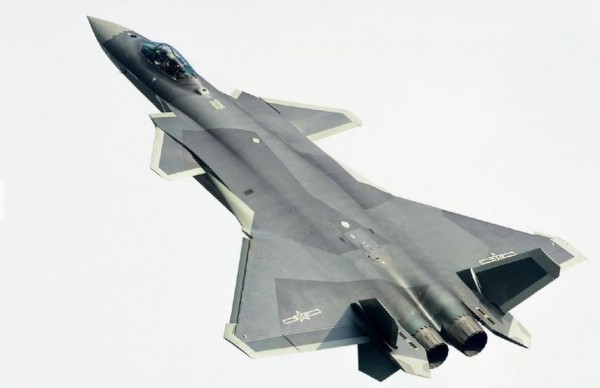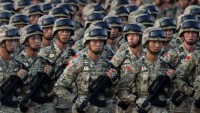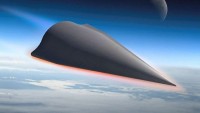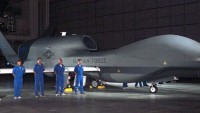China’s J-20 Stealth Jet isn’t an Air Superiority Fighter; will Attack US Warships Instead
| Arthur Dominic Villasanta | | Oct 21, 2016 07:48 AM EDT |
(Photo : PLAAF) Chengdu J-20 in war paint.
China's much-hyped Chengdu J-20 fifth generation stealth fighter seems doomed to a career attacking U.S. Navy warships and U. S. Air Force aerial refueling tankers because of its crippling disabilities as an air superiority fighter.
The J-20, which made its first flight only in 2011, was never intended as an air superiority fighter armed with the stealth and advanced electronics that will allow it to prevail against its two premier antagonists: the Lockheed Martin F-35 Lightning II and the Lockheed Martin F-22 Raptor.
Like Us on Facebook
In Asia, however, the J-20 will see battle against the F-35, a squadron of which is already operational in Japan with the United States Marines.
It seems China isn't certain of the J-20's true calling. This 5th gen jet is billed as a long-range air superiority fighter that's also a multirole combat aircraft. But its design points more towards the J-20 being a long-range maritime strike jet than an aerial superiority fighter.
The jet's huge size (20 meters long with a wingspan of 13 meters) means it can carry more fuel for longer range patrols. It also means it's less stealthy since this massiveness compared to the F-35 (which is five meters shorter in length) will reveal it faster to an F-35.
More tellingly, the J-20's design is what called "forward stealth," meaning the J-20 is only truly stealthy when seen by radar head-on. From the side, the rear and because of its larger size, the J-20 has a radar cross section that's not that of a stealth aircraft.
Some analysts feel the J-20 is more accurately described as a "low observable" (LO) aircraft instead of a true stealth aircraft because of its many design deficits. These include its forward stealth design and its use of canards that sacrifice stealth.
An American analyst believes the J-20's combination of forward stealth and long range is more of a danger to the U.S. Navy than the U.S. Air Force. The jet's long-range maritime strike capability should also concern the U.S. military more that its capability as an air-superiority fighter.
Its unreliable engines also preclude the J-20 from taking on either of the American stealth fighters on anything approaching equal terms. The J-20 prototypes are underpowered because their twin Saturn AL-31F engines produce about 30,000 lbs of thrust each compared to the 35,000 lbs delivered by the F-35's engines.
It's not clear if the jets now in low rate initial production will have this engine or the more powerful WS-15. This new engine, however, remains under development.
The availability of more powerful and reliable engines should transform the J-20 into a credible air superiority fighter. But without these new engines, the J-20 is at its best when attacking huge and practically defenseless aircraft such as aerial tankers and airborne early warning aircraft.
The J-20 is expected to enter service with the People's Liberation Army Air Force in 2018 at the earliest.
TagsChengdu J-20, stealth jet, forward stealth, low observable, U.S. Navy
©2015 Chinatopix All rights reserved. Do not reproduce without permission
EDITOR'S PICKS
-

Did the Trump administration just announce plans for a trade war with ‘hostile’ China and Russia?
-

US Senate passes Taiwan travel bill slammed by China
-

As Yan Sihong’s family grieves, here are other Chinese students who went missing abroad. Some have never been found
-

Beijing blasts Western critics who ‘smear China’ with the term sharp power
-

China Envoy Seeks to Defuse Tensions With U.S. as a Trade War Brews
-

Singapore's Deputy PM Provides Bitcoin Vote of Confidence Amid China's Blanket Bans
-

China warns investors over risks in overseas virtual currency trading
-

Chinese government most trustworthy: survey
-

Kashima Antlers On Course For Back-To-Back Titles
MOST POPULAR
LATEST NEWS
Zhou Yongkang: China's Former Security Chief Sentenced to Life in Prison

China's former Chief of the Ministry of Public Security, Zhou Yongkang, has been given a life sentence after he was found guilty of abusing his office, bribery and deliberately ... Full Article
TRENDING STORY

China Pork Prices Expected to Stabilize As The Supplies Recover

Elephone P9000 Smartphone is now on Sale on Amazon India

There's a Big Chance Cliffhangers Won't Still Be Resolved When Grey's Anatomy Season 13 Returns

Supreme Court Ruled on Samsung vs Apple Dispute for Patent Infringement

Microsoft Surface Pro 5 Rumors and Release Date: What is the Latest?













